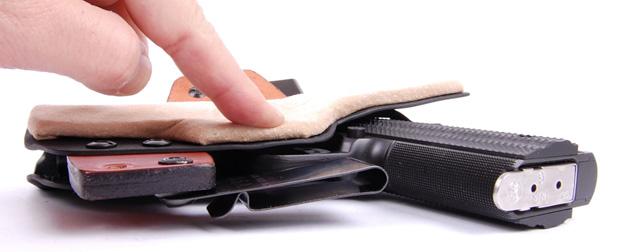HOLSTER COMFORT
August 30 2016
When planning to purchase a holster for your firearm, it is vitally important to purchase a holster which properly fits the required revolver or pistol, and will safely and securely retain the weapon during the type of activities envisioned while wearing it. Often times, people will shop for exactly that and essentially overlook a very key element… COMFORT. If comfort isn't taken into account, the wearer will be desiring a whole new holster within just a few weeks or even days. Buyer beware! Ignoring this element will lead to severe frustration (i.e. ‑ Holster Rage) and is entirely preventable from the beginning.
In this blog, we will explore some of the key elements, components, enhancements and terms that are associated with holsters and the relation to overall comfort. Specifically in regards to Holster Comfort, it is not just how easy the holster itself is to wear, but also how effective it is to be used normally (amongst planned activities), that doesn't require unnatural or potentially dangerous body movements to draw and re-holster the firearm.

Carry Location
The first element to always consider, where on the body will the firearm be carried? Depending on the overall size of the desired handgun, it might be too large or bulky to carry in certain locations of the body, immediately eliminating certain variances of holsters. Traditionally, most holsters are on the hip with a belt, ensuring the added weight doesn't affect movement throughout the day. Some holsters can be carried around an ankle, thigh or waist. Others are made to be worn using a harness, allowing the pistol or revolver to be carried under the arm (referred to as shoulder holsters). Imagination and practicality are the only restrictions on carry.

Of primary concern, and not to be taken lightly, will the added weight and/or mass of the holster be worn comfortably during intended activities throughout the day, without getting in the way of other daily functions? Ensure that it is worn securely, because a holster that is continually flopping around will become very annoying.

Padding
Many holsters are designed to actually be pressed directly against the body, so make sure that the material incorporated between the skin and holster is soft, comfortable, and won't cause any chaffing. Again, it is very important to ensure that the holster is worn securely, because as it moves around, it will begin to rub and this can be very irritating. Many holster manufacturer's incorporate what's referred to as a "sweat guard". This is a functional part of the holster that protrudes from the holster, placing a barrier between the wearer and the top of the firearm, preventing direct skin contact with the weapon. This does one of two (2) things: Stops the discomfort that might happen when the hard pistol or revolver is pressing against the abdomen, and will also prevent generated body sweat from reaching the firearm itself. Metal and mineral-rich moisture (aka sweat) don't mix well, and this can help protect the finish of a handgun

Cant
The cant of a holster is used to enhance the practicality of function and use of the holster as worn. Holsters with a forward cant (the grip is angled towards the front of the body, and the barrel indexes rearward as worn), is designed to be easier to conceal and prevent the printing of the worn firearm. Sometimes, and depending on the clothes worn, the actual grip of a sidearm can cause an outline, protruding through an over garment. This is commonly referred to as "printing". In some states, printing is legally considered brandishing a firearm, and can create a legal mess that is just best to avoid. With a forward cant holster, the grip gets rotated in a vertical aspect, which greatly reduces the chance of printing to occur.

Holsters with a rearward cant, are usually more difficult to conceal, but are often times more comfortable to draw from. The wrist and elbow are allowed a more natural draw angle, facilitating a faster draw of the weapon.
In Conclusion
There are a great many elements and choices to consider in selecting the right holster. Some decisions might lead to one style of holster or another, but the purpose of a holster is to carry a pistol or revolver for a length of time, and lead up to dismissing the overall comfort factor. Don't! This is a huge mistake and will often times equivocate to having entire drawers or bins filled with holsters that are never used. Those that routinely carry, gravitate to holsters that are comfortable to wear for extended periods. Save time and money by planning in advance and purchase a holster that is comfortable to wear, don't compromised!

Recents Posts
September 26 2018
Train Like You Fight with a Good Set of Ear Plugs
July 04 2018
A Holster by Any Other Name is Still a Holster
June 03 2018
DNA Tactical Self-Defense Tools
May 15 2018
A Guide to Handgun Holsters
April 19 2018
Waistband v. Shoulder v. Ankle: The Great Holster Debate
April 05 2018
Essential Gear Components for Disaster Survival
March 22 2018
Protecting Your Eyes on the Range is Plain Common Sense
January 24 2018
Customize Your Gear to Win the Fight of Your Life
January 19 2018
How to Choose A Hand-Held Light
January 11 2018
How to Choose a Hands-Free Light
January 08 2018
The Right Holster for Everyday Carry? You are Your Own Expert
December 11 2017
Emergency Outdoors Medicine and Rescue
December 10 2017
Cordage and Accessories for Survival and Outdoors
December 03 2017
Choosing and Using Survival Knives
November 25 2017
The First Priority of Survival
